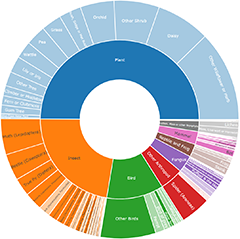Announcements
24 Sep 2025
Hi NatureMapr Data Collector app users,If you experience the following error when attempting to upload sightings from the NatureMapr Data Collector mobile app, please note the following known issue an...
Continue reading
NatureMapr moves to simpler, flatter national structure
Mobile App update and known issues
Discussion
DonFletcher
wrote:
30 min ago
Or, given the location, this may be an escaped pet, or descended from a pet, with the colour having resulted from selective breeding.
Oryctolagus cuniculus
DonFletcher
wrote:
32 min ago
When there is a large population of rabbits in an area, the rare colour forms can be evident. When rabbit density is low, rare colour forms are unlikely to be detected, but they are still present. So if you see a rare colour form, it may be that you came across it by luck in a low density population. The popular sayings that unusual colour forms result from inbreeding and that rare colour forms prove rabbit density is high, are both likely to be myths imo.
Oryctolagus cuniculus
WendyEM
wrote:
1 hr ago
In my experience Orgyia (Teia) has denser webbing on her cocoon and lays the eggs in a clump, not evenly scattered all over her cocoon .
Anestia (genus)
Significant sightings
- Phascolarctos cinereus
- Paraselina brunneri at Nightcap, NSW
- Paropsis pantherina at Broke, NSW
- Galadistes pilligaensis at The Pilliga, NSW
- Callocephalon fimbriatum at Aranda, ACT
- Daphnandra micrantha at Pappinbarra, NSW
- Litoria raniformis
- Keyacris scurra at Penrose, NSW
- Callocephalon fimbriatum at Hughes, ACT
- Perunga ochracea at Yarralumla, ACT
Top contributors
- AlisonMilton 17.2K
- trevorpreston 16.2K
- Hejor1 15.2K
- Tapirlord 12.1K
- Mike 10.9K
- MichaelBedingfield 10.8K
- RodDeb 10.5K
- kasiaaus 9.9K
- ConBoekel 9.8K
- KylieWaldon 9.2K
Top moderators
- MichaelMulvaney 61.5K
- Tapirlord 41.8K
- MichaelBedingfield 23.8K
- Liam.m 22.4K
- donhe 18.3K
- natureguy 15.7K
- ibaird 15.6K
- MatthewFrawley 12.3K
- AlisonMilton 11.1K
- plants 9.1K








































![Unverified Cap on a stem; pores below cap [boletes & stemmed polypores] at O'Malley, ACT - Today by Mike Unverified Cap on a stem; pores below cap [boletes & stemmed polypores] at O'Malley, ACT - Today by Mike](https://api.naturemapr.org/api/sightings/4703293/images/1?width=300&height=300)






































































